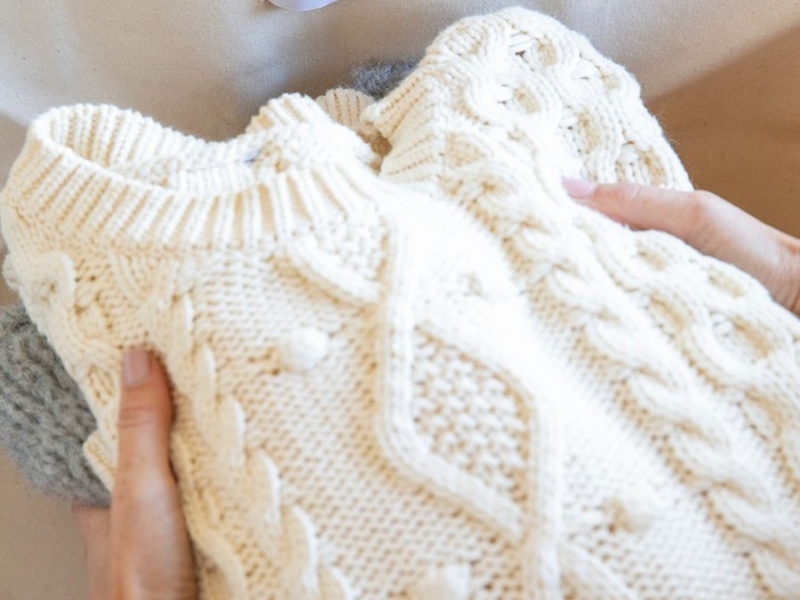Contents
Undo Unintentional Shrinkage The Final Takeaway
Laundering clothes can be stressful. Without reading the tag, it’s all too easy to wash and dry pieces on the wrong settings, which can transform the way they look, feel, and fit. Hot water can make dark dyes fade, while cold water is said to be less effective than warmer temps when it comes to rinsing viruses out of garments (though, this is still up for debate); and while a normal cycle works perfectly well on, say, jeans and tees, it can be too rough for delicate items like lingerie and silk. Knowing how to wash your clothes is the key to avoiding any unwanted changes, but also if your goal is to alter your items in the wash, understanding the effects of different washing methods comes in handy. Ahead, we spoke with two fabric experts to get their best tips on how to shrink clothes at home, complete with fabric considerations, precautions, and four methods you can try.
Why Do Clothes Shrink in the Wash?
Not all garments shrink in the wash, but some do. “During the manufacturing process, fabrics and garments are put under stress and tension, so when shrinkage happens after you get garments home and wash them, it’s because they’re trying to return to their fully relaxed and un-stressed state,” explains Downy senior scientist Sammy Wang.
But how do you know which pieces might shrink? “While shrinkage occurs in general as fabrics try to return to their equilibrium, there are several factors that can influence the type and degree of shrinkage you may experience, including fiber type, drying method, and fabric construction,” Wang tells us. Generally speaking, fibers that shrink easily include cotton, wool, silk, and linen, and drying on high heat is more likely to cause shrinkage than doing so on cooler temps.
Should I Shrink My Clothes at Home?
If you have a piece of clothing you want to intentionally shrink, your first thought may be to do the opposite of the care instructions on the tag, but Wang says it's not that simple. “Because there are so many types of clothes and so many associated variables, unfortunately there’s no way to fully predict how a garment may shrink and change, so we don’t recommend intentionally shrinking clothes,” she says. “To take the best care of your garments, always follow the instructions on the care label.” Still, while it's not exactly officially endorsed, our experts do have a few tips if you decide to shrink your clothes at home anyway—scroll on to learn what you need to keep in mind if you give it a go.
Fabric Considerations
As we mentioned, some fabrics shrink better than others. “Cellulosic fibers like cotton or rayon are more prone to shrinkage, so machine washing and drying on a high temperature may give you the desired shrinkage,” Wang says. “Synthetic fibers like polyester, nylon, spandex, and elastane are less likely to shrink, so while you can also try machine washing and drying on a high temperature, you may not see the shrinkage you’re looking for.”
The construction of the fabric also plays a role in how susceptible it is to shrinking. “Knit fabrics such as T-shirts and sweaters will shrink more because there is more space between fibers, but they also have more elasticity so they can regain their shape more easily,” Wang says. “Woven fabrics such as dress pants are less likely to shrink because they are already tightly woven, but they also will not regain their shape as easily as a knit.”
Then there’s wool, which can shrink a lot but can ultimately experience irreparable damage in the process. “Wool that is dry-clean-only should not be washed because it will shrink excessively,” Wang warns. “Wool requires heat, moisture, and agitation to shrink, all of which are present in machine washing and drying. So while you may see a change in size, it may be extreme and render the item unwearable.”
Precautions
Before we tell you how to shrink your clothes at home, allow us to reiterate: It’s not a foolproof solution for creating smaller clothes. “Because of all of the variables in garments, it’s difficult to control or predict the shrinkage and damage when intentionally shrinking clothes at home, but shrinkage in garments can be up to a 10% change in dimensions, so there’s a pretty wide range of what you could experience when intentionally shrinking clothes at home,” Wang says. “Also, some manufacturers ‘pre-shrink’ fabrics so they will not change size at all—but if it is not advertised, there’s no way to tell if a garment is already pre-shrunk, so you may end up damaging clothes without even seeing the desired shrinkage.”
Click here to preview your posts with PRO themes ››
How to Shrink Clothes at Home
Even though shrinking your clothes at home isn’t fully advisable—your garment may shrink in ways you don’t intend, such as in the width but not the length—we understand you might want to give it a go regardless. Knowing that, ahead you’ll find four ways to shrink your clothes at home.
- Turn up the heat: “If you want to shrink your clothes on purpose, this can be achieved by using the washing machine and the dryer at a high temperature, as heat is the primary way to shrink clothing,” says textile expert and Steamery co-founder and CEO, Frej Lewenhaupt. “[Still], I generally do not recommend trying to shrink your clothing since it requires a lot of energy and can be harsh, causing [clothing pieces] to not only shrink but lose their shape, color, and luster.”
- Know your fabric: Not all clothes shrink in the washer and/or dryer. To give yourself the best chance of success, Wang says to experiment with natural fibers. “Natural fibers like cotton [shrink the best] because natural or cellulosic fibers are more hydrophilic or ‘water-loving’ and tend to absorb moisture and swell, contributing to shrinkage,” she explains. Meanwhile, if you try to shrink polyester in the wash, it’s unlikely to change shape unless it’s blended with a natural fiber.
- Wash on a high soil level: Another way to manipulate your garments is by altering the level of agitation in your washing machine. Typically, the higher the soil level you set your machine to, the longer it will soak the fabrics and the more it will agitate overall. “Hot water is not always necessary as water saturation and agitation are what create the shrinkage conditions for cotton during the wash cycle,” Wang explains. Thus, you can wash your clothes in the recommended temperature, and simply turn up the intensity. “The water and agitation during the wash and the mechanical tumbling action during machine drying will cause fibers to shrink, and the higher heat drying and agitation can help to ‘set’ the shrinkage,” Wang adds. “You can repeat this process several times to get closer to your desired outcome.”
- Soak your clothes in boiling water: The water a washing machine produces may be hot, but it’s not boiling. With this in mind, some TikTokers report that you can enhance your at-home shrinkage by starting the process in a stainless steel bowl filled with boiling water. For best results, submerge the garment in the piping-hot water, let it sit for 20 to 30 minutes, squeeze the water out with tongs, then toss the piece of clothing into a high-heat tumble dry.
Can You Undo Clothing Shrinkage?
Even if you follow the above instructions to a T, it's still possible that you'll get a result you didn't want. “Unfortunately, there is no way to predict how your garment will behave just by looking at it, which is why we don’t recommend intentionally shrinking clothes at home,” Wang says. That said, if you unintentionally shrink something, there are ways to potentially right the wrong—check out the steps to try below.
- Create a solution: “Fill a bucket or other container with room-temperature water and add half a cap of fabric softener, mixing thoroughly—the fabric softener will lubricate and condition fibers, allowing them to move around more easily,” Wang reveals.
- Let it sit: Give the fabric time to sit so the solution can work its magic. “Saturate and soak the garment in the solution for around 15 minutes, then gently rinse with cold water and wring out any excess,” Wang tells us.
- Allow your piece to air-dry: After removing and wringing out your garment, gently stretch it and allow it to dry on a flat surface or drying rack. “For future washes, wash and dry according to the care label,” Wang reminds us.
The Final Takeaway
While adjusting your wash settings as well as trying certain soaking methods can shrink or alter your clothes, doing so isn't recommended, as you don't fully know how it will turn out. If you're trying to make a garment smaller, your best bet would be to have it tailored. That being said, if you're careful and follow the above steps carefully, you have a better chance of success at shrinking your clothes at home than if you simply were to try the opposite of the care instructions. Just proceed with caution—if you start slow, you're less likely to get a dramatic, unwanted result.


